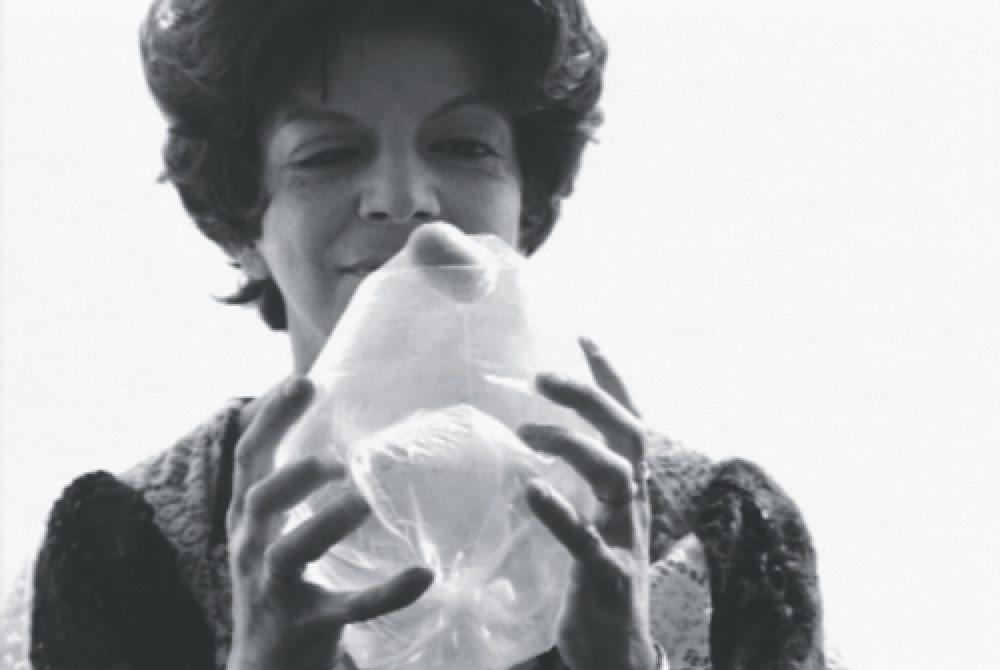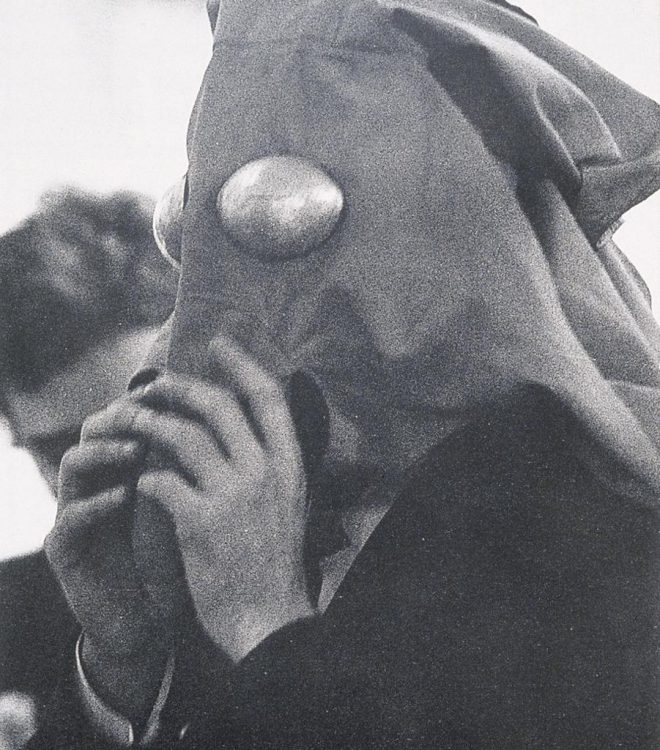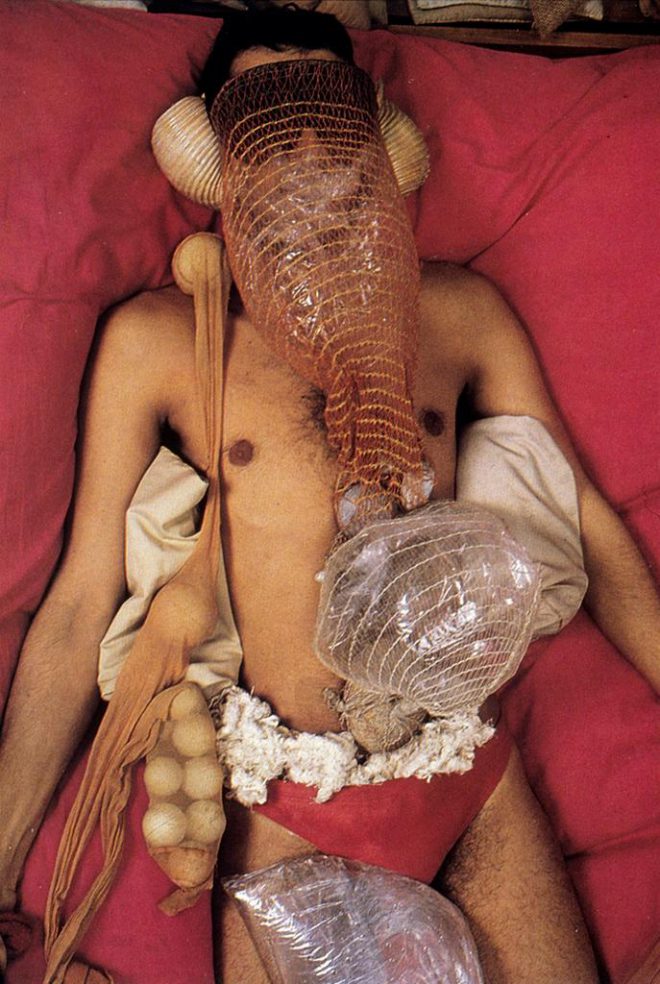Presence, Silence, Intimacy, Duration: Lygia Clark’s Relational Objects
Adrian Anagnost looks at Brazilian artist Lygia Clark’s turn away from art-making toward the creation of therapeutic objects and experiences.

Lygia Clark, Pedra e ar [Stone and Air], 1966. Courtesy the World of Lygia Clark, Rio de Janeiro.
In the 1970s, Brazilian artist Lygia Clark ceased creating artworks. She was living in Paris, having self-exiled there in September 1968 due to growing repression by the Brazilian military dictatorship (1964-85). At that time, Paris was a haven for artists and intellectuals from across Latin America—including numerous Brazilians—who were seeking refuge from right-wing politics in their home countries. But Clark was slightly isolated from the Latin American expat scene in Paris. Most of her friends and colleagues, including her key artistic interlocutor, Hélio Oiticica, had scattered more widely, to London and New York. And at 48, a grande dame from a wealthy background, Clark was dissociated from the bohemian sociability of Paris’ 1968 generation. Additionally, the 1968 Venice Biennale marked a close to Clark’s professional involvement in the international art world (save a brief re-engagement in art exhibitions just before her death in the late 1980s), as she turned her artistic strategies toward more therapeutic pursuits.
Nostalgias of the Body
Already in the 1960s, Clark had begun shifting away from discrete objects whose intended focus was aesthetic contemplation. Instead, she created tactile, wearable, and sharable works that emphasized viewer participation and corporeal engagement. Clark’s deceptively simple Caminhando [Walking Along], 1963, consisted of directions to create a paper Möbius strip, then cut down the strip to divide it in half—an action that creates a narrower, longer continuous loop. The action was to continue until additional cutting would destroy the strip. In this way, the task of cutting was turned into a durational act of creation.
The 1966 work Diálogo de mãos [Dialogue of Hands], a collaboration with Oiticica, transformed the solitary Caminhando into a duet. A thick Möbius strip made of stretchy material links two participants’ hands, with each individual’s movements initiating a cascade of tensions and responses in their partner’s hand. That same year, Clark created Pedra e ar [Stone and Air], a pebble perched upon a small plastic bag filled with air. The receptive viewer would palpate the inflated bag, and the pressure of his or her hands would cause the pebble to dance. Instead of art as precious museum objects, Clark deployed common materials and ephemeral forms to produce durational experiences.
Clark’s Máscaras Sensoriais [Sensory Masks], 1967-68, enveloped participants’ heads in sculptural hoods. Tucked into the hood’s folds were sachets of varied textures and aromas (lavender, cloves, a salty seaside odor). Combined with a disorienting reduction of visual stimuli, these sachets would spur participants’ disengagement with their visual surroundings in favor of a rediscovery of bodily experience and an immersive inner world. Around the same time, Clark’s O eu e o tu [The I and the You], 1967, aimed at collective disorientation, as two participants donned rubber suits connected by a sort of umbilical cord. The suits contained crevices participants were intended to explore, both in their own suit and in their partner’s. Throughout the 1960s, Clark’s aesthetic investigations vacillated between solitude and collectivity. Yet these works were unified in their efforts to expand artistic experience. Rather than contemplation of painting or sculpture, art became an intersubjective practice rooted in affective embodiment.

Lygia Clark, Máscaras Sensoriais [Sensory Masks], 1967–68. Courtesy the World of Lygia Clark, Rio de Janeiro.
Psychodramas
Throughout the 1970s, Clark’s work gradually moved beyond the bounds of art. There was no sudden rupture, but a gradual shift from a psychoanalytically-infused art to psychotherapy steeped in sensuous experience. First as an art instructor at the Sorbonne, and then in a therapeutic practice she operated out of her apartment, Clark developed works that drew upon her previous aesthetic experimentation to create what art historian Yve-Alain Bois has called “psychotherapeutic experiments.”
With students at the Sorbonne, Clark elaborated a collective and embodied therapy in which there was no division between viewer and participant. In Bába antropofágica [Anthropophagic/Cannibalistic Drool], 1973, each student (in Bois’ words) “sucked a reel of colored thread which they then unwound directly from their mouths onto one of their colleague stretched out on the ground, the body of the latter gradually buried under a mottled web of regurgitations.” That same year, Clark and her students carried out the work Antropofágia [Cannibalism], in which an individual lay supine on the floor, with a pouch full of fruit over their stomach. The other participants, who were blindfolded and communicating through touch alone, sought to find and eat the fruit from the pouch.
Given their emphasis on orality, and on nonverbal or preverbal communication, scholars have linked these works to Clark’s study of Austrian-British psychoanalyst Melanie Klein and her student, D. W. Winnicott. Clark was interested in Klein’s notion of the stage of oral incorporation during infancy, as a way to differentiate self from other, and in Winnicott’s work on “transitional objects,” e.g. blankets or soft toys which children touch, caress, bite, chew, hug, hit, and hold. Winnicott theorized that these objects served to help children through the process of differentiating “me” from “not-me,” facilitating the discovery of a world separate from self.
Clark had a personal investment in the process of mental healing, as she herself was undergoing analysis with Swiss existential psychologist Ludwig Binswanger and French psychoanalyst (and student of Gilles Deleuze) Pierre Fédida. However, her method, as she described it, drew more directly from the relaxation techniques developed by Russian-French psychoanalyst Michel Sapir. Sapir’s method relied upon addressing patients with words intended to “awaken the imagination”—the words varied at each session in a kind of verbal Rorschach—combined with therapeutic touch. As Clark narrated in a text from around 1980:
I used...the application of Sapir’s method through which I had passed in Paris: relaxation based in verbal inducement, one session per week. I gradually abandoned inducement, beginning to use only my own materials...The process becomes therapeutic through the regularity of the sessions, which allows the progressive elaboration of the phantasmic provoked by the potentialities of the “relational objects.” In manipulating the “relational object,” the subject lives out a pre-verbal image. The “relational object” directly touches the subject’s nucleus (emphasis added).
For example, with the 1974 work Flor: “Relaxação” [Flower: “Relaxation”], which Clark developed with her students at the Sorbonne, flowers were placed atop a blindfolded figure lying on the ground. Over the course of the 1970s, first in Paris and then back in Rio de Janeiro, Clark would transform such playful, collective practices into the mechanism for one-on-one therapy sessions. Like Flor, these sessions deployed objects in ways that can also be understood in terms of Winnicott’s “transitional objects,” but they also drew on Sapir’s relaxation techniques and the legacy of Clark’s own artistic experimentation.

Lygia Clark’s Relational Objects, 1976–82. Courtesy the World of Lygia Clark, Rio de Janeiro.
As Clark described, in her therapy sessions she used objects of different weights and densities, aromas and textures, pressing them upon or laying them on a patient’s body: heavy cushions, foam rubber, plastic bags filled with air or water, a mesh bag with stones inside, a cloth pouch filled with seeds, a flashlight to shine into blindfolded eyes, a loofah, seashells to place over the ears, marbles, rabbit’s tails, nylon stockings filled with Ping-Pong balls or stones or shells, and so on. What marks Clark’s practice apart from her psychoanalytic models, and at the same time makes her practice assimilable to an art context, is her use of these “relational objects.” Many commentaries have seen this therapeutic deployment of objects to be implicit in Clark’s earlier works, such as Pedra e ar, the small plastic bag that receptive viewers would manipulate to bounce a small stone.
Legacies
And therein lies the challenge of thinking about Clark’s late works within an art context: Since her later “therapeutic” works formally resemble her earlier “art” works, can both be exhibited as art? Some commentators point out that she returned to art exhibitions near the end of her life. However, another response would be to insist that these therapeutic actions are not artworks at all, and cannot or should not be presented in an art context. A 2014 exhibition at the Museum of Modern Art in New York opted for an equivocal stance. Certain of Clark’s collective works from the 1970s period at the Sorbonne were re-staged, while her therapeutic works were—in a sense—recapitulated by contemporary artists and practitioners who led workshops in the spirit of (rather than strictly recreating) Clark’s therapeutic works.
Clark herself furiously opposed subsuming her works under the categories of performance or body art, which she saw as infused with a certain sadism on the part of the artist toward the viewer. Moreover, her works were emphatically against the voyeuristic aspect of much performance art, in which artists’ exhibitionism played into the fantasies of the viewers.
For Bois, “The psychotherapeutic experiments conducted by Lygia during the last ten years of her life certainly did not lend themselves to any direct presentation, but at least they could be described (Lygia was a passionate writer).” It is a somewhat paradoxical claim, given that Clark’s writing insisted on the pre-verbal image that arose in the context of her therapeutic practice. Yet Bois is right that, in the absence of the works’ immanence, or the body of the artist/therapist herself, a practice of reading may best summon their presence, silence, intimacy, and duration.



